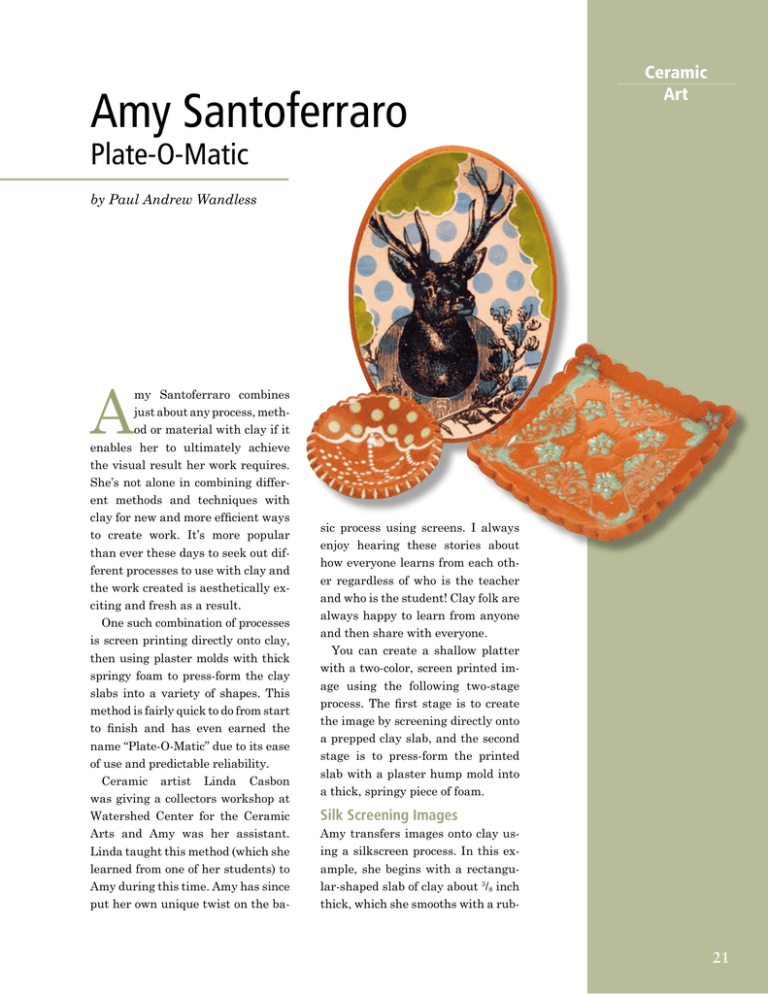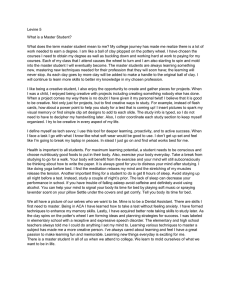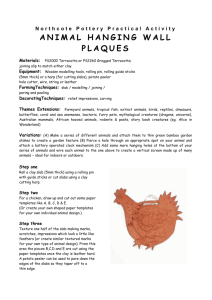Amy Santoferraro - Ceramic Art Daily
advertisement

Amy Santoferraro Ceramic Art Plate-O-Matic by Paul Andrew Wandless A my Santoferraro combines just about any process, method or material with clay if it enables her to ultimately achieve the visual result her work requires. She’s not alone in combining different methods and techniques with clay for new and more efficient ways to create work. It’s more popular than ever these days to seek out different processes to use with clay and the work created is aesthetically exciting and fresh as a result. One such combination of processes is screen printing directly onto clay, then using plaster molds with thick springy foam to press-form the clay slabs into a variety of shapes. This method is fairly quick to do from start to finish and has even earned the name “Plate-O-Matic” due to its ease of use and predictable reliability. Ceramic artist Linda Casbon was giving a collectors workshop at Watershed Center for the Ceramic Arts and Amy was her assistant. Linda taught this method (which she learned from one of her students) to Amy during this time. Amy has since put her own unique twist on the ba- sic process using screens. I always enjoy hearing these stories about how everyone learns from each other regardless of who is the teacher and who is the student! Clay folk are always happy to learn from anyone and then share with everyone. You can create a shallow platter with a two-color, screen printed image using the following two-stage process. The first stage is to create the image by screening directly onto a prepped clay slab, and the second stage is to press-form the printed slab with a plaster hump mold into a thick, springy piece of foam. Silk Screening Images Amy transfers images onto clay using a silkscreen process. In this example, she begins with a rectangular-shaped slab of clay about 3/8 inch thick, which she smooths with a rub- 21 Ceramic Arts Handbook Tools and supplies for this process include simple hump/drape molds and 3-inch blocks of soft foam. Texturing tools, cutters and printing supplies are all optional. 22 ber rib. The slab should be roughly 3 inches larger than the hump mold you’re planning on using to assure it conforms to the whole shape. (Note: Amy uses terra cotta for this demo, but any clay body can be used.) For a base color, she then coats the surface with porcelain slip (figure 1) brushed evenly across the entire surface with a wide brush. Once the slip dries a bit and the shine is gone, she smooths it with a rubber rib to remove any brush marks (figure 2). Although porcelain slip is used here, you can use any white or tinted slip—whatever background you want for your piece. Tip: Prep two or three slabs at a time so you have extras to work with. emulsion. Each screen is printed us- Screen a Two-Color Image screen into the open areas (figure To make a two-color print, Amy uses two screens with images burned into them using diazo photosensitive 4). Next, she applies another bead ing a different color with the first screen being the background pattern and the second screen the primary image. Commercial underglazes need to be the right consistency for silk screening to avoid bleeding edges on the image. To get underglazes to the consistency of honey, Amy leaves them open overnight so some of the water can evaporate. Before printing on the clay, you need to load the open areas of the silk screen with color. Amy applies a bead of underglaze across the length of the screen (figure 3), then using a squeegee with a stiff rubber blade, she draws the underglaze across the of slip on the screen then carefully lowers the screen onto the clay slab Ceramic Art 1 Prepare a slab and coat with slip. 2 Use a rib to smooth the surface. 4 Use a squeegee to charge the screen. (figures 5–6). Once in place, she screens the image onto the slab creating a background of light blue circles (figure 7). The second screen has several images in it so Amy uses wax paper on the bottom of the screen to block out all the images not being used (figure 8). The screen is then “loaded” with thickened black underglaze, lined up over the slab and screened over the blue circles (figure 9). The finished image is left to dry for 15– 20 minutes or until it’s dry to the touch. Once the image is dry, check 3 Place a bead of slip on the silk screen. 5 Place another bead of slip on the screen. 6 Carefully place the screen over the slab. the slab to see if it has stiffened enough to handle but is still flexible (figure 10). Forming the Plate Center the clay slab on a piece of thick springy foam and use a damp sponge to clean the surface of the plaster hump mold (figure 11). Be sure the piece of foam is larger than the mold being used. Place the mold over the area of the print that will be the final composition, taking into consideration how the shape and depth of the mold will interact 23 Ceramic Arts Handbook 7 8 Squeegee slip to transfer the design to the slab. Mask off areas of the screen you will not use. 10 Allow one slab to set up, but make sure it is still flexible. A second screen with a second color is added. 11 Place slab on foam rubber and prepare a mold. with the image you created. Trim a wide border, leaving enough clay to conform to the mold (figure 12) and remove the excess slab. Keep your trimming tool handy because you’ll need it after forming the plate. Place both hands on the mold and press with slow even pressure until the back of the mold is roughly even with the surface of the foam (figure 13). While keeping pressure on the mold, trim and remove excess clay from the edge of the mold to create the rim (figure 14). Amy cuts at an angle so the rim also acts as a bor- 24 9 12 Trim excess clay from the slab before pressing. der. If you cut straight down, the rim will have more of an edge where the image or design would end at the perimeter. Finishing Touches To finish the plate, keep one hand on the mold, and flip the plate and remove the foam. Use a rubber rib to smooth the bottom of the plate (figure 15). Once the bottom is finished, flip the plate back over and remove the mold (figure 16). Finish the rim with a Surform tool and rubber rib. Amy hand-glazed additional images on her plate. The finished piece Ceramic Art 13 Use even pressure and press mold into clay. 16 Place the completed piece on flat surface and remove mold. 14 Hold mold down and trim remaining excess. 15 Keep slab on mold and use rib to smooth the surface. 17 As a variation, create a decorative edge prior to molding. 18 Press slab into foam. looks wonderful and was simple to make. Once you have prepared slabs, this whole press forming process should only take about 15 minutes per plate. shape that you designed yourself. Templates and Stamping patterns to emboss a design, pattern Like most techniques, you can vary this process. If screening isn’t your thing, try one of these alternatives to make plates or bowls that are even quicker to perform and use common items. Choose a template or form with an interesting profile or edge. This can be a plastic form or even a drawn Trace and carve the shape of its perimeter into the clay creating the edge of your plate (figure 17). Use stamps with interesting designs or or composition into the clay; then line up the plaster mold and press into the foam creating the depth desired for the piece (figure 18). Once the form is pressed, remove and clean up with a rubber rib and other finishing tools as needed. This is a really simple way to create a plate with a complex embossed design 25 Ceramic Arts Handbook 19 26 20 Piece showing scalloped edge and texture added before pressing. Add feet to the bowls made with this process if desired. (figure 19). Glaze or slip can be applied in the recessed areas (mishma technique) or a simple celadon can be applied. For more variations, try using cookie cutters, pastry or tart pans or small dough cutters and cut out forms. Press the clay into the foam with a half-sphere plaster mold and add a foot if desired. Leave the mold inside to act as resistance to press against when making the foot. Amy uses a small coil and attaches and smooths it with her fingers (figure 20). A damp sponge can also be used to run around the foot for final smoothing of the surface. These are just two variations that can be applied to this Plate-O-Matic method, and the possibilities really are endless. Just keep a few things in mind when experimenting with this process. Remember that the hump mold you’re using must be slightly smaller than the slab so you’re sure to get a good rim after pressing into the foam. The foam itself needs to be at least 4 inches thick and “springy” so you can achieve good depth in the plates or bowls. Seat cushions work well or you can get thick springy foam at a craft store.


